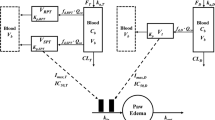Abstract.
Objective and Design: To determine whole blood levels of sirolimus, a macrolide antibiotic in the rat developing adjuvant arthritis (AA) model after dosing orally with two different vehicles, and whether combinational doses of sirolimus and cyclosporin A (CsA) produced additive or synergistic inhibitory effects in this model.¶Material: Male Lewis rats (150-180g).¶Treatment: Arthritis was induced by the injection (0.5 mg/rat) of heat-killed Mycobacterium butyricum suspended in light mineral oil. Drugs were administered orally either in fine suspension (0.5% Tween 80) or in emulsion (phosal 50 PG in 1% Tween 80) at doses of 0.1 to 5 mg/kg in a 7 day, MWF or daily regimen.¶Method: Paw volumes (ml) were measured by automated mercury plethysmograph and sirolimus concentrations in whole blood were quantitated by liquid chromatography/mass spectroscopy.¶Results: At 72 h (7 days after adjuvant) after receiving the third oral dose (4.5 mg/kg p.o.), the phosal vehicle resulted in higher sirolimus blood levels (2.5 ng/ml) than in Tween 80 (1.6 ng/ml). After the rats received the last oral dose on day 14, (7 total doses of sirolimus at 4.5 mg/kg) the sirolimus blood levels (2 h after the last dose) were about 2 times higher for the phosal dosed rats (9.8 ng/ml) compared to Tween 80 dosed rats (4.6 ng/ml). Even 24 h after the last dose, sirolimus blood levels were still elevated in the phosal dosed rats (0.8 ng/ml) relative to 0.5% Tween 80 dosed rats (0.5 ng/ml). At day 16 in the rat developing model, sirolimus, when given in phosal vehicle, produced an ED50 of 0.28 mg/kg (i.e. inhibition of uninjected paw edema) that was about 5.5 times lower than using 0.5% Tween 80 as the suspending agent (ED50 = 1.6 mg/kg). When combining sirolimus and CsA using precalculated doses for producing an additive effect in this adjuvant model, an additive inhibitory effect on uninjected paw edema was observed at equal combinational doses of 0.5 and 2 mg/kg, respectively.¶Conclusions: The phosal vehicle used in administering sirolimus increases the absorption and whole blood levels in the rat and the elevated blood levels correlated positively with the therapeutic effect in the rat developing AA model. In addition, combination therapy using sirolimus and CsA produced an additive effect in rat developing AA.
Similar content being viewed by others
Author information
Authors and Affiliations
Additional information
Received 31 December 1998; returned for revision 24 March 1998; accepted by G. Letts 14 May 1998
Rights and permissions
About this article
Cite this article
Carlson, R., Hartman, D., Ochalski, S. et al. Sirolimus (rapamycin, Rapamune®) and combination therapy with cyclosporin A in the rat developing adjuvant arthritis model: Correlation with blood levels and the effects of different oral formulations. Inflamm. res. 47, 339–344 (1998). https://doi.org/10.1007/s000110050339
Issue Date:
DOI: https://doi.org/10.1007/s000110050339




